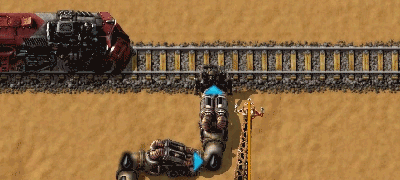Fluid wagon
| Fluid wagon |
Object description
The fluid wagon, also known as the rail tanker, is capable of transporting fluids by rail. Fluids can be pumped in and out of the wagon using a pump, each fluid wagon can have a maximum of 3 pumps attached at one time, 1 per tank section. Similar to cargo wagons, a locomotive is required to move the liquid wagon.
The fluid wagon can carry 50,000 units of fluid. It weighs the same of the regular cargo wagon but holds more fluid; a cargo wagon filled with barrels can carry 20,000 units of fluid.
Troubleshooting
To get fluid into the fluid wagon, you need a train station with pumps.
The wagon needs to be aligned with the rail grid; do this by using a train stop as a train schedule destination, and a fueled locomotive.
Also make sure that the rails under the Fluid wagon are straight rails and not curved rails. The pumps will only work if the wagon is perfectly orthogonal to the grid.

Load and unload times
Using more pumps per wagon reduces (un)loading time. A maximum of 3 pumps can be used for each wagon. Pump quality![]() affects pumping speed.
affects pumping speed.
| Pump quality | 1 pump | 2 pumps | 3 pumps |
|---|---|---|---|
| 42 | 29 | 14 | |
| 33 | 17 | 11 | |
| 27 | 14 | 9 | |
| 22 | 11 | 8 | |
| 17 | 9 | 6 |
Times given are rounded up.
History
- 2.0.7:
- Capacity increased from 25000 to 50000 to make fluid wagons more compelling compared to the new pipe mechanics.
- 0.16.8:
- Changed fluid wagon capacity from 75k to 25k (same as storage tank).
- Lowered fluid wagon weight from 3000 to 1000 (same as cargo wagon).
- Changed fluid wagon recipe so it requires just 1 storage tank instead of 3.
- 0.16.7:
- Simplified to contain just 1 fluid instead of having 3 different fluid tanks.
- 0.15.0:
- Introduced
